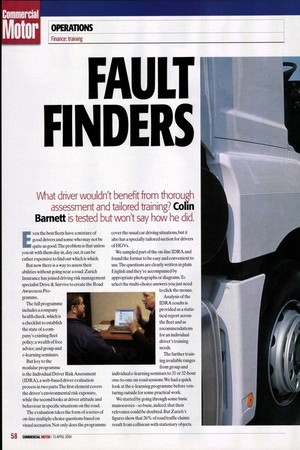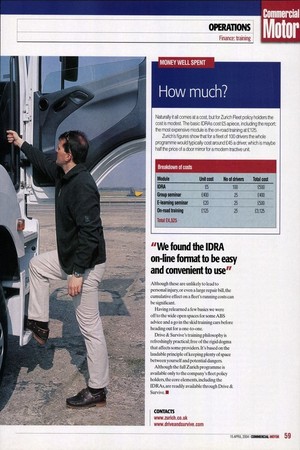FAULT FINDERS
Page 56

Page 57

If you've noticed an error in this article please click here to report it so we can fix it.
What driver wouldn't benefit from thorout assessment and tailored training? Cohn
Barnett is tested but won't say how he did.
Even the best fleets have a mixture of good drivers and some who may not be quite as good.The problem is that unless you sit with them day in, day out, it can be rather expensive to find out which is which. But now there is a way to assess their abilities without going near a road: Zurich Insurance has joined driving risk management specialist Drive & Survive to create the Road
Awareness Programme.
The full programme includes a company health check, which is a checklist to establish the state of a company's existing fleet policy; a wealth of free advice; and group and e-learning seminars. But key to the modular programme
is the Individual Driver Risk Assessment (IDRA), a web-based driver evaluation process in two parts.The first element covers the driver's environmental risk exposure, while the second looks at driver attitude and behaviour in specific situations on the road. The evaluation takes the form of a series of on-line multiple-choice questions based on visual scenarios. Not only does the programme
cover the usual car driving situations, but it also has a specially tailored section for drivers of HGVs. We sampled part of the on-line IDRA and found the format to be easy and convenient to use.The questions are clearly written in plain English and they're accompanied by appropriate photographs or diagrams.To select the multi-choice answers you just need
to click the mouse.
Analysis of the IDRA results is provided as a statistical report across the fleet and as recommendations for an individual driver's training needs. The further training available ranges
from group and individual e-learning seminars to 31 or 32-hour one-to-one on-road sessions. We had a quick look at the e-learning programme before venturing outside for some practical work.
We started by going through some basic manoeuvres — so basic, indeed, that their relevance could be doubted. But Zurich's figures show that 26% of road traffic claims result from collisions with stationary objects.
Although these are unlikely to lead to personal injury, or even a large repair bill, the cumulative effect on a fleet's running costs can be significant.
Having relearned a few basics we were off to the wide open spaces for some ABS advice and a go in the skid training cars before heading out for a one-to-one.
Drive & Survive's training philosophy is refreshingly practical; free of the rigid dogma that affects some providers. It's based on the laudable principle of keeping plenty of space between yourself and potential dangers. Although the full Zurich programme is available only to the company's fleet policy holders, the core elements, including the IDRAs, are readily available through Drive & Survive. •
























































































































































































